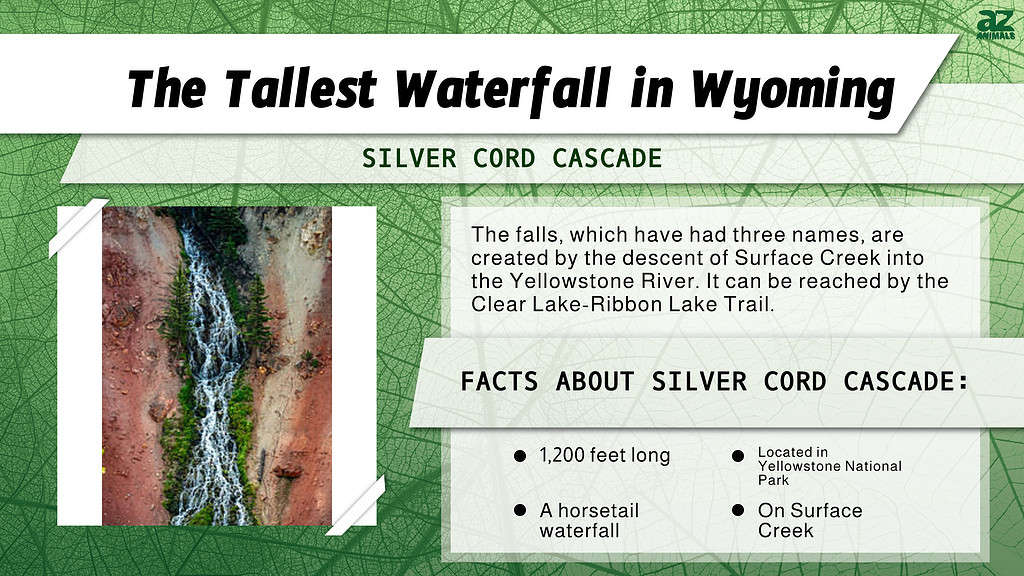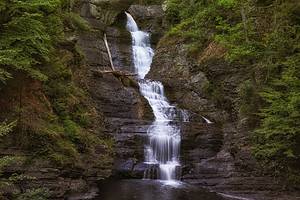Wyoming is known for its stunning National Parks, including Grand Teton and Yellowstone. The state is famously very sparsely populated, leaving room for the area’s natural wonders. If you do make the trip up to Wyoming, the state’s tallest waterfall is a sight you won’t want to miss.
Located in Yellowstone National Park, this waterfall requires a short hike to access, but the view and the area’s natural wonders make everything worthwhile.
What Is the Tallest Waterfall in Wyoming?

The tallest waterfall in Wyoming is the Silver Cord Cascade, which plunges 1,200 feet. The waterfall flows from Surface Creek, a tributary of the Yellowstone River. Silver Cord Cascade is also considered the tallest waterfall in Yellowstone.
Silver Cord Cascade is known as a “horsetail” waterfall. According to World Waterfalls, a horsetail waterfall occurs when the descending water remains in contact with the rock surface the majority of the time. Horsetail waterfalls are typically long and thin, giving them the appearance of a horse’s tail.
History of the Falls
Silver Cord Cascade has been an important part of Yellowstone’s history for well over a century. According to an informational page from Yellowstone National Park, members of the Washburn Expedition discovered the waterfall in 1870.
Two members of the party, Samuel Hauser and Benjamin Stickney, are credited with naming the cascade Silverthread Falls. Then the park superintendent changed the name to Sliding Cascade in 1883. However, in 1885 the USGS Hague parties changed the name to Silver Cord Cascade.
In the late 1880s, this spot became a popular lookout point for early visitors to Yellowstone National Park. Due to this activity, Superintendent P.W. Norris built a railing in 1880 and named the location Lookout Point, a title that remains to this day.

The Silver Cord Cascade flows from Surface Creek, a tributary of the Yellowstone River, pictured here.
©iStock.com/samuel howell
Where Is Silver Cord Cascade Located on a Map?
Silver Cord Cascade is located in Wyoming, within Yellowstone National Park. The waterfall is in the northwestern corner of the state, not far from the bordering states of Montana and Idaho. It is straight north of Yellowstone Lake and straight east of West Yellowstone, Idaho.
How to Access Silver Cord Cascade
Getting a glimpse of Silver Cord Cascade requires a bit of hiking. One way to get a glimpse of the waterfall is by taking the Seven Mile Hole Trail. In total, this route is a strenuous 10-mile trail that offers views of Silver Cord Cascade from across the canyon.
However, you don’t have to hike the entire route to get a glimpse of the waterfall. World of Waterfall states that the first glimpse of the cascade is only about a mile from the Glacial Boulder Trailhead, making the whole route two miles in total. NPS also warns that grizzly bears frequent this area, so take the proper precautions.
Wildlife Around Silver Cord Cascade
Wyoming is one of the best states to explore nature and see wildlife living in its natural habitat. The state is home to over 100 species of mammals and 400 species of birds.
Silver Cord Cascade is located within Yellowstone National Park, so there are unsurprisingly many opportunities to see wildlife in the area. Whether you’re bird-watching or hoping to spot a larger mammal, keep your eyes peeled for these creatures around Silver Cord Cascade.
Birds
Hundreds of species of birds have been sited in Yellowstone National Park. In fact, National Park Services (NPS) reports that records of bird sightings have been kept since 1872.
While in the area surrounding the Silver Cord Cascade, you might spy raptors such as bald eagles, owls, and falcons. You may also hear the sound of woodpeckers or the cheerful melodies of songbirds like chickadees. Wetland birds like swans, ducks, and geese may also be spotted in the nearby waters.

Those visiting Silver Cord Cascade may see or hear woodpeckers and many other birds.
©Benjamin King/Shutterstock.com
Mammals
Yellowstone is home to a diverse assortment of mammals both large and small. While visiting the park you might spot bison, bighorn sheep, and elk or predators such as black and grizzly bears or mountain lions. Smaller critters in Yellowstone include weasels, ground squirrels, gophers, and marmots.
Reptiles and Amphibions
A number of reptiles and amphibians make their home in Yellowstone National Park. While visiting Silver Cord Cascade, keep an eye out for one of the most common venomous species of snake in the area — the prairie rattlesnake. Other species, such as the common garter snake, are harmless.
In Yellowstone, you may also spy a number of amphibians, from the Western tiger salamander to the boreal chorus frog.
Fish
The Silver Cord Cascade is a part of Surface Creek, which flows off of Ribbon Lake. Surface Creek is also a tributary of the Yellowstone River. There is an abundance of fish in these bodies of water.
Yellowstone cutthroat trout are some of the most widespread native fish in the area. NPS lists twelve native species in the park, including suckers, mountain whitefish, and mottled sculpins. Non-native fish that have been introduced in the area include brook, brown, and lake trout.
Activities Around Silver Cord Cascade
There are a number of activities to partake in while visiting Silver Cord Cascade. As we mentioned previously, accessing the waterfall requires a short hike, but adventurous hikers can always continue their journey and hike the full Seven Mile Hole Trail.
Visiting the waterfall also offers ample opportunities for bird and other wildlife watching. Bringing along a sketchbook or high-quality camera is one way to document the area’s flora and fauna.
The nearby Yellowstone River houses a variety of fish species and is a popular spot for fly fishing in particular. Finally, overnight camping is allowed in Yellowstone National Park, though it requires a backcountry permit.
The photo featured at the top of this post is © Kelly vanDellen/Shutterstock.com
Thank you for reading! Have some feedback for us? Contact the AZ Animals editorial team.







